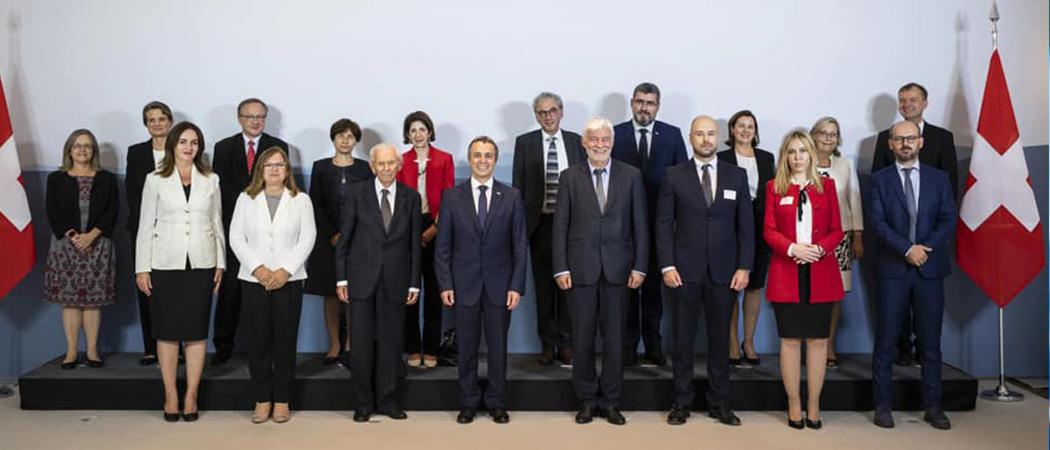It may have R&D relationship woes with the EU, but Bern is boosting science diplomacy as part of a new foreign policy strategy, and is stepping in to help this fractious region get a shared research infrastructure off the drawing board

Switzerland received ministers from SEEIIST member countries on 13 September. Image: SEEIIST Facebook page
Switzerland is to draw on its science diplomacy experience to help steer the construction and governance of the South East European International Institute for Sustainable Technologies (SEEIIST), the first large research infrastructure in the Western Balkans.
Seven countries in the Balkans and Kosovo have teamed up to deliver the €200 million research lab that would apply advances in particle physics to medical technologies and use proton or ion beams to deliver precision treatment of tumours, sparing healthy tissue.
The design phase of the project is completed, but it now needs a long-term legal entity, and agreement on where the facility will be built, to move forward.
Switzerland is stepping in to play an active role in helping SEEIST establish a governance structure and to oversee an international competition for the location of the new facility. The move comes as the country launches a new foreign affairs strategy, which includes science diplomacy as one of its key pillars.
As home of CERN, the world’s largest particle physics laboratory, Switzerland has broad experience in setting up, managing and running international research infrastructures. CERN and Switzerland also played a significant role in establishing the Sesame synchrotron in Jordan, where scientists from across the Middle East work together, promoting peace and international cooperation.
Sanja Damjanović, a Montenegrin physicist who until March this year was the chair of the SEEIIST steering committee said working together on a common scientific project could help the people in the region think beyond political, ethnic and religious differences. “The Western Balkans urgently needs large scale research infrastructures,” Damjanović told Science|Business.
Damjanović was replaced by Bulgarian physicist Leander Litov, who has a two-year mandate. Damjanović is former science minister of Montenegro, which has promoted the project since 2016, but was replaced after her party lost the parliamentary elections in August 2020.
But science diplomacy comes “above all local political differences,” said Damjanović. The project is set to outlive multiple government changes.
The idea for SEEIIST was first put forward in 2016 by experimental physicist and former CERN director general, Herwig Schopper, who also initiated the Sesame synchrotron. A year later, in March 2017, Montenegro was the first country in the region to give the project political backing, helping establish SEEIIST as a joint regional project involving Albania, Bosnia and Herzegovina, Bulgaria, the Republic of Kosovo, Montenegro, the Republic of North Macedonia, Serbia and Slovenia. Croatia and Greece are observing members.
Swiss push for science diplomacy
Earlier this year, Switzerland appointed a special representative for science diplomacy as part of a new foreign policy agenda. The first to take on the new role is Alexandre Fasel of International Geneva, Switzerland’s main forum for promoting dialogue between scientists and diplomats.
According to the new foreign policy strategy, Switzerland will use science diplomacy as an explicit tool in pursuing its foreign policy goals. “As an innovative country and home to a large scientific community, Switzerland has the assets and credibility to play this facilitating role," Switzerland’s vice president Ignazio Cassis told a SEEIIST meeting in Bern earlier this month.
At the meeting, SEEIIST asked Switzerland to coordinate two working groups representing all the countries involved in the project, to establish the legal status of the research centre and to set out the criteria for choosing the site for the facility.
“[SEEIIST] gives an idea of what our science diplomacy could look like,” Niccolo Iorno, scientific adviser at the Swiss Federal Department of Foreign Affairs told Science|Business.
The goal is to bring international scientists around joint research projects, as a way to establish cooperation in sensitive regions. Switzerland will seek to get foreign ministers involved as well, and not leave negotiations for the construction of SEEIIST entirely up to science ministers. “Our hope is that governments will get ownership of the project by having also their foreign affairs ministries involved,” said Iorno.
EU money is needed
While Switzerland is offering to help with the governance, the project still needs EU cash. The €200 million needed will come from various sources, but SEEIIST expects EU cohesion funds for the Western Balkans will pay a significant chunk of the costs, along with contributions from EU pre-accession funds, and contributions from member governments.
Last year the EU announced a new enlargement strategy that included an economic development plan for the Western Balkans. Talks on EU expansion are now stalled, but countries in the regions are in the process of being accepted to become associated in the EU’s Horizon Europe research programme. Kosovo was the first country to gain the status in August, meaning its researchers can apply for a slice of the €95.5 billion budget.
SEEIIST was included in the region’s own agenda on innovation and research but it needs EU structural and cohesion funds to move forward. The project is not included in the Commission’s economic and investment plan it launched in December 2020 for the region.
SEEIIST also submitted an application to be included in the European Strategy Forum on Research Infrastructures (ESFRI) roadmap back in 2020, but the bid was not successful.




 A unique international forum for public research organisations and companies to connect their external engagement with strategic interests around their R&D system.
A unique international forum for public research organisations and companies to connect their external engagement with strategic interests around their R&D system.